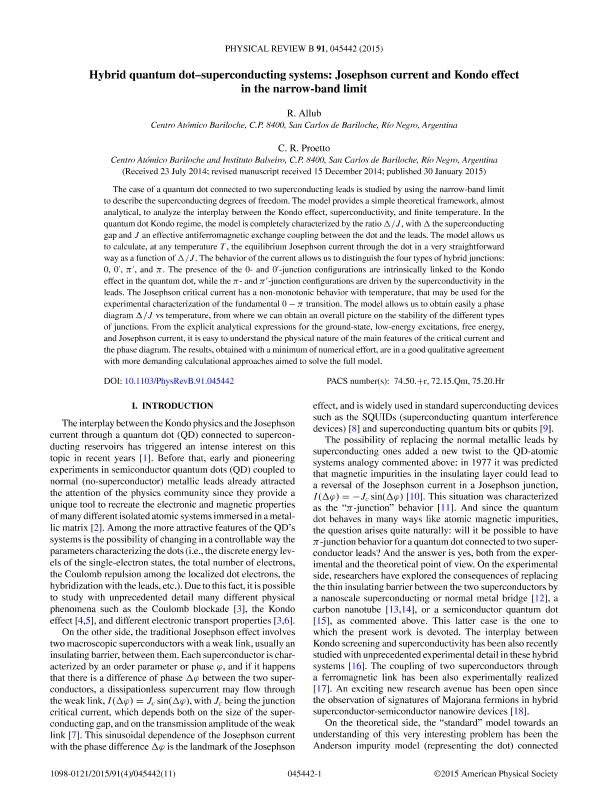Mostrar el registro sencillo del ítem
dc.contributor.author
Allub, Roberto Jose

dc.contributor.author
Proetto, Cesar Ramon

dc.date.available
2018-08-01T14:51:13Z
dc.date.issued
2015-01-30
dc.identifier.citation
Allub, Roberto Jose; Proetto, Cesar Ramon; Hybrid quantum dot - superconducting systems: Josephson current and Kondo effect in the narrow-band limit; American Physical Society; Physical Review B: Condensed Matter and Materials Physics; 91; 4; 30-1-2015; 4544201-4544211
dc.identifier.issn
1098-0121
dc.identifier.uri
http://hdl.handle.net/11336/53733
dc.description.abstract
The case of a quantum dot connected to two superconducting leads is studied by using the narrow-band limit to describe the superconducting degrees of freedom. The model provides a simple theoretical framework, almost analytical, to analyze the interplay between the Kondo effect, superconductivity, and finite temperature. In the quantum dot Kondo regime, the model is completely characterized by the ratio /J , with the superconducting gap and J an effective antiferromagnetic exchange coupling between the dot and the leads. The model allows us to calculate, at any temperature T , the equilibrium Josephson current through the dot in a very straightforward way as a function of /J . The behavior of the current allows us to distinguish the four types of hybrid junctions: 0, 0 , π , and π. The presence of the 0- and 0 -junction configurations are intrinsically linked to the Kondo effect in the quantum dot, while the π- and π -junction configurations are driven by the superconductivity in the leads. The Josephson critical current has a non-monotonic behavior with temperature, that may be used for the experimental characterization of the fundamental 0 − π transition. The model allows us to obtain easily a phase diagram /J vs temperature, from where we can obtain an overall picture on the stability of the different types of junctions. From the explicit analytical expressions for the ground-state, low-energy excitations, free energy, and Josephson current, it is easy to understand the physical nature of the main features of the critical current and the phase diagram. The results, obtained with a minimum of numerical effort, are in a good qualitative agreement with more demanding calculational approaches aimed to solve the full model.
dc.format
application/pdf
dc.language.iso
eng
dc.publisher
American Physical Society

dc.rights
info:eu-repo/semantics/openAccess
dc.rights.uri
https://creativecommons.org/licenses/by-nc-sa/2.5/ar/
dc.subject
Superconductivity
dc.subject
Kondo Effect
dc.subject
Josephason Current
dc.subject.classification
Astronomía

dc.subject.classification
Ciencias Físicas

dc.subject.classification
CIENCIAS NATURALES Y EXACTAS

dc.title
Hybrid quantum dot - superconducting systems: Josephson current and Kondo effect in the narrow-band limit
dc.type
info:eu-repo/semantics/article
dc.type
info:ar-repo/semantics/artículo
dc.type
info:eu-repo/semantics/publishedVersion
dc.date.updated
2018-07-11T15:00:25Z
dc.journal.volume
91
dc.journal.number
4
dc.journal.pagination
4544201-4544211
dc.journal.pais
Estados Unidos

dc.journal.ciudad
Nueva York
dc.description.fil
Fil: Allub, Roberto Jose. Comisión Nacional de Energía Atómica. Gerencia del Area de Investigación y Aplicaciones No Nucleares. Gerencia de Física (Centro Atómico Bariloche); Argentina. Consejo Nacional de Investigaciones Científicas y Técnicas. Centro Científico Tecnológico Conicet - Patagonia Norte; Argentina
dc.description.fil
Fil: Proetto, Cesar Ramon. Comisión Nacional de Energía Atómica. Gerencia del Area de Investigación y Aplicaciones No Nucleares. Gerencia de Física (Centro Atómico Bariloche); Argentina. Consejo Nacional de Investigaciones Científicas y Técnicas. Centro Científico Tecnológico Conicet - Patagonia Norte; Argentina
dc.journal.title
Physical Review B: Condensed Matter and Materials Physics

dc.relation.alternativeid
info:eu-repo/semantics/altIdentifier/doi/http://dx.doi.org/ 10.1103/PhysRevB.91.045442
dc.relation.alternativeid
info:eu-repo/semantics/altIdentifier/url/https://journals.aps.org/prb/abstract/10.1103/PhysRevB.91.045442
Archivos asociados
